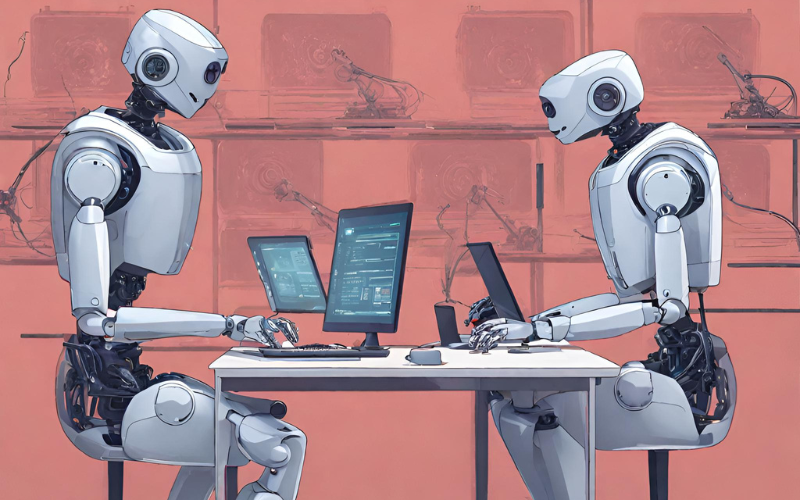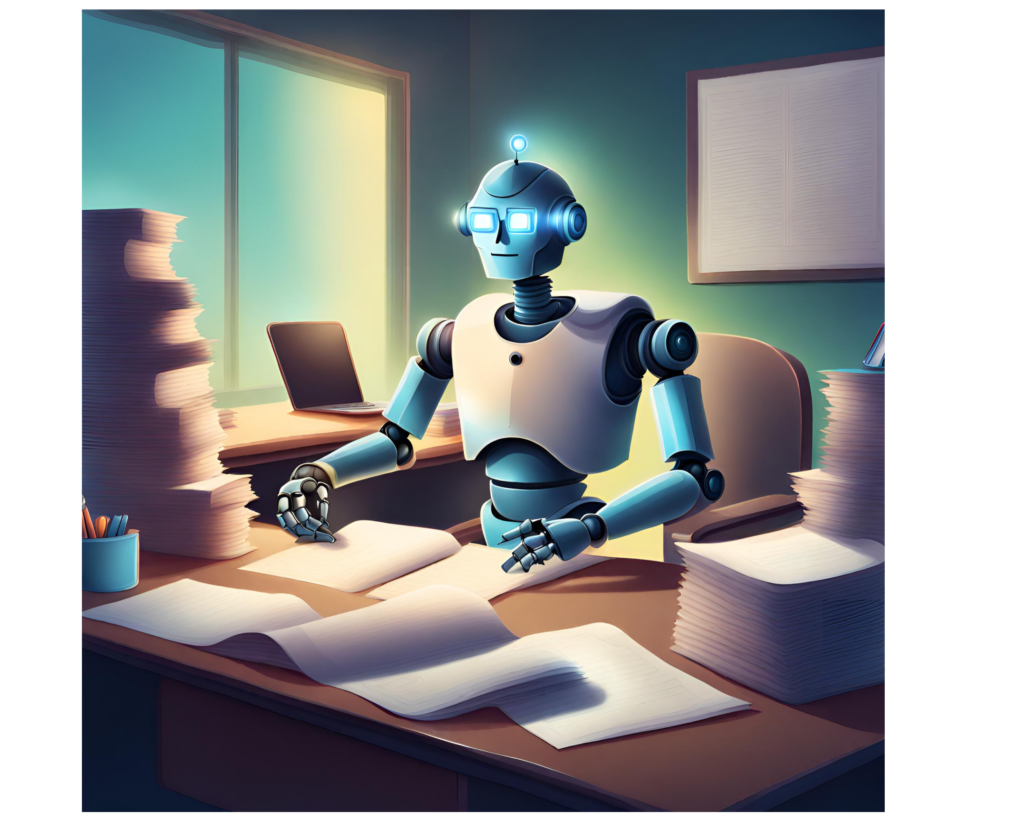I was listening to a podcast interview last week and heard one of the speakers mention that if there was a feature length movie in the future about the history of artificial intelligence (AI), that we are currently in the first 10 seconds of the trailer. That triggered me to write a few thoughts about AI.
Rather than head toward recent articles that I’ve bookmarked or saved as pdf’s, I thought I would review my emails received today (December 7) through 11am. There were 10 that mentioned AI. Yesterday, I received 29 that mentioned AI and that does not include any that I deleted.
After a quick review of the 39 emails with AI content, I believe they’re representative of the current news, reports, and marketing announcements. At the same time, there’s probably more news about AI than this overview.
Calls for Regulation of AI
The Washington Post reported that Senators expect AI committee work to ramp up in 2024. Senator Chuck Schumer and the leaders of his bipartisan working group on artificial intelligence announced that they expect key committees will dial up efforts to craft AI legislation in the next year.
Some lawmakers are getting frustrated that the forums held by Sen. Schumer have not led to legislation. Sen. Josh Hawley stated that he intended to try to pass legislation to explicitly exempt generative AI tools from receiving protections under Section 230, the tech industry’s embattled legal shield.
New York Times reporters Adam Satariano and Cecilia Kang wrote an article for the December 6th issue of the Times titled How Nations Are Losing a Global Race to Tackle A.I.’s Harms. Their article mentions the April 2021 European Union draft law to regulate AI and how EU lawmakers were blindsided by the Chat GPT release last year because it was an unconsidered form of AI.
The Biden Administration’s October 30th Executive Order on Artificial Intelligence was also mentioned. The order focuses on the use of AI to allow terrorists to make weapons of mass destruction (WMD) or deep fakes to swing elections or swindle consumers. The order was limited in scope because Congress needs to legislate most regulation of the private sector.
UK Prime Minister Rishi Sunak’s November 1-2 Artificial Intelligence Safety Summit was attended by 28 nations. As an outcome, all 28 nations signed the Bletchley Declaration. The Declaration focuses on safety from AI and among its signatories were China and the U.S.

The discussions about regulations reminded me about the 140 higher ed organizations that announced a statement of six principles at the United Nations Internet Governance Forum on October 9th. The six principles are:
- People, not technology, must be at the center of our work.
- We should promote digital inclusion within and beyond our institutions.
- Digital and information literacy is an essential part of a core education.
- AI tools should enhance teaching and learning.
- Learning about technologies is an experiential, lifelong process.
- AI research and development must be done responsibly.
The group of university leaders responsible for developing the principles encouraged other universities world-wide to sign on.
Continuing Advancements in ChatGPT and other LLMs
Wired Magazine’s Will Knight reported the announcement of Google’s launch of Gemini. Gemini can work with text, images, audio, and video and its initial version was being rolled out inside Google’s chatbot Bard. Because its training was not limited to text like ChatGPT, Google believes that Gemini is capable of more advanced reasoning than ChatGPT 3.5 and scored higher than ChatGPT-4 on the Massive Multitask Language Understanding (MMLU) benchmark.
Mr. Knight quoted Oren Etzioni, former CEO of the Allen Institute for AI, who said “there’s no reason to disbelieve that Gemini does better than ChatGPT-4 on these benchmarks, but the next version, GPT-5, will do better than that. This is a take-no-prisoners, must-win war.”
Meanwhile, Wharton School professor Ethan Mollick published An Opinionated Guide to Which AI to Use: ChatGPT Anniversary Edition. He encourages those who can afford it to subscribe to ChatGPT4 even though Gemini was just announced (but unavailable). He notes that getting access to ChatGPT-4 may be harder since OpenAI temporarily suspended new subscribers.
Professor Mollick offers a short-term solution for access to GPT-4 which is that people access Microsoft’s Bing. To use GPT-4, you must select Bing’s Precise or Creative Mode. The default mode does not use GPT-4.
Productivity Tools using AI
It has been widely publicized that Chat GPT-4 is being incorporated in the Microsoft Office 365 suite. PCMag’s Joe Hindy reported that GPT-Turbo, Deep Search, and four other features are coming to Microsoft’s Co-Pilot.
GPT-4 Turbo brings the OpenAI LLM model’s knowledge base up to April 2023 and increases the amount of information that can be ingested by the model at one time. Microsoft EVP Yusuf Medhi announced that the model is being tested and will be widely integrated in the coming weeks.
Microsoft also announced enhancements to DALL-E3 that provide higher quality image creation and better responsiveness to prompts. These enhancements can be accessed through bing.com/create or through a Copilot prompt to create an image.
Deep Search on Bing uses GPT-4 to optimize search results for complex topics. If a search phrase has several meanings, Deep Search will let you pick which one is best. It will even rewrite the first query to get the best possible answer.
Code Interpreter is a new add-on that allows the user to perform complex tasks such as more accurate calculations and math. Microsoft is still testing this tool with select users and plans to release it soon.

New Books on AI
Veteran educator Carl Hooker provided an overview of his book, Learning Evolution: New Era of AI in the Classroom, for Tech & Learning. Mr. Hooker lists five things that AI can and cannot do for students.
5 Things that AI can do for students right away are:
- Brainstorm ideas.
- Feedback & editing suggestions
- Review your work
- Reading & writing assistance
- Tutoring and support
5 Things that AI cannot do for students include:
- AI cannot care for students
- AI cannot motivate students to learn
- AI cannot be empathetic
- AI cannot understand a student’s learning style
- AI cannot provide life guidance.
I suspect that the list of things that AI cannot do will decrease over time.
AI Research Reports
Heidrick & Struggles, the international executive recruiting organization, announced its 2023 Europe and US Data, Analytics, and Artificial Intelligence Executive Organization and Compensation Study. Highlighted findings from the survey include:
- 10% of respondents overall said their company does not currently have an AI strategy leader.
- 37% of respondents think their company’s AI, data, and analytics function is either industry-leading or among the best and 12% think they have room for improvement.
- Customer or technical service and product development are currently the areas in which respondents are most commonly using AI.
- 52% of respondents indicate that they don’t have adequate funding to build the data and analytics program their company needs.
- Two years from now, 57% of respondents expect to be using AI for recruitment and HR, up from 17%.
- Only 29% of respondents said that generative AI specifically was contributing to a measurable business improvement today. 45% said they have not seen measurable improvement yet because they are piloting the use of AI before using it more widely.
- Reported average cash compensation for data, analytics, and AI executives in the U.S. was $605,000 and in Europe, $382,000.
The Tech Transparency Project announced that Meta and its CEO, Mark Zuckerberg, have contributed to a broad array of colleges and universities across the country, raising questions about their potential to influence the institutions. The two biggest grants were funded by the Chan Zuckerberg Initiative (CZI).
One CZI grant provided between $800 million and $1 billion to a biomedical research consortium of UC Berkeley, Stanford, and UC San Francisco. The other provided $500 million to launch the Kempner Institute for Natural and Artificial Intelligence at Harvard.
The Washington Post also reported that the University of Cambridge used Google money to expand the work of the Centre for Human-Inspired Artificial Intelligence to advance AI research for the benefit of humanity. Per the Washington Post, the TTP reported that Google funded 331 research papers on subjects related to its business interests between 2005 and 2017.
Qualtrics released its 2024 Consumer Trends Report unlocking feedback from 28,000 consumers across 26 countries. Trend 1 from the report is titled Human connection is the foundation of a winning AI strategy. Most consumers are still on the fence about AI, but 48% are comfortable interacting with an organization’s AI for simpler, transactional activities.
The report has a handy chart outlining the various preferences score (see below).
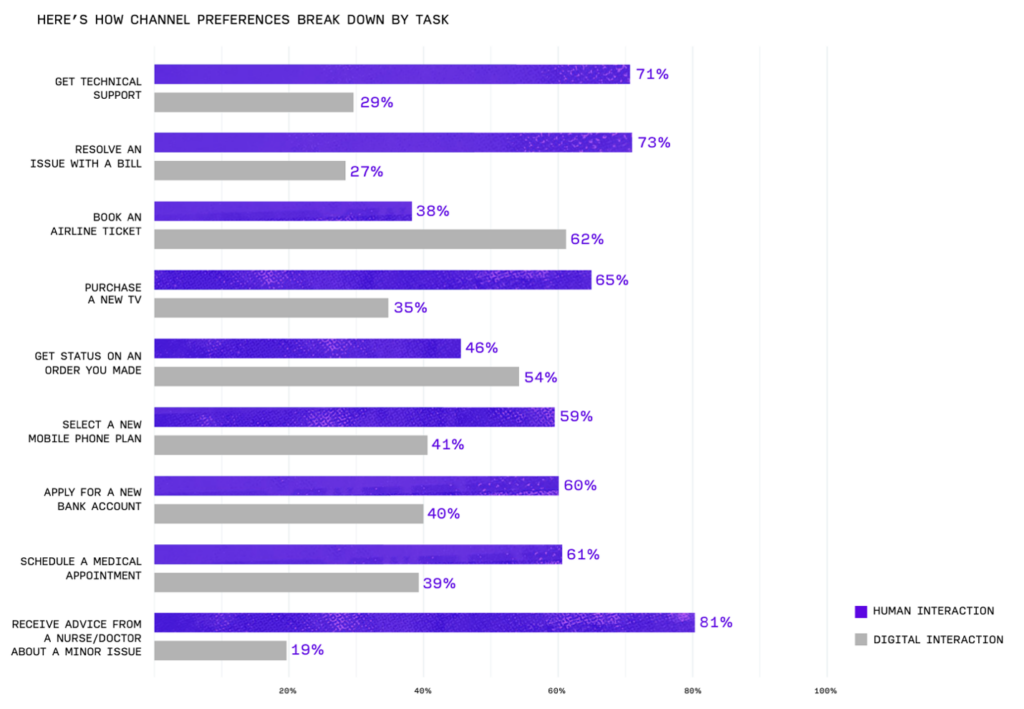
Qualtrics’ researchers note that “an effective AI strategy is not simply deploying more chatbots and automating tasks. Instead, look to the technology to empower your frontline teams with the tools, time, and insights to build stronger connections with your customers and make that a better experience too.
The Webby Reports released its 2024 Webby Trend Report titled The Race to Outpace. Only 18% of consumers surveyed believe that AI products are innovating at the right speed. More than 40% believe that AI is innovating too quickly.
The four industries that believe AI will impact their professions the most are media and production, tech, advertising and marketing, and entertainment. See chart below for a full review of the data.
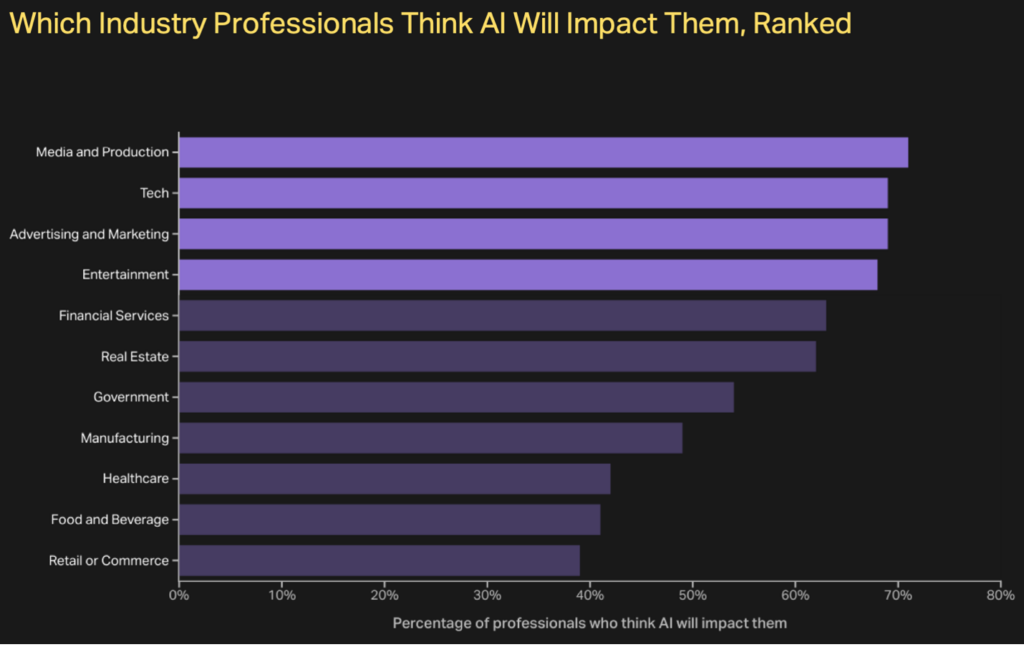
The report identifies four key areas where individuals can partner with AI to improve their capabilities at work. These are productivity, personalization, imagination, and social impact.
Among the surprising survey results was the revelation that 48% of the survey respondents who are employed full time replied that they already use AI tools with 26% stating that they use it very often. Microsoft’s Office 365 co-pilot product was cited as one of the most popular AI productivity tools.
Nearly 60% of 18-34-year-olds believe that companies should use AI to personalize the shopping experience. AI personalization tools designed to craft more personalized experiences are:
- Persona GPT – create AI personas for your consumers
- Artifact – hyper-personalize your news feed, summarize long articles, and build links
- PalM2 – interact with Google AI products in a natural way
- Dynamic Yield – personalize customer experience with agility across platforms
- Mailchimp Marketing Automation – drive personalized messages that scale with your business
- Persado – Optimize marketing with innovative and personalized language generation
- Dynatrace – Identify abnormal behavior, security, and performance issues
- Amazon Rekognition – Extract information and insights from your images and videos
The report’s researchers write that “market research will play a key role in informing brands’ decision-making in the deployment of AI, from product development to optimizing user experience.”
In the imagination area, half of professionals who have worked in entertainment or media & production are more motivated than others to get a head start. The figure below shows the percentages of employees in each industry that are using AI for creative production.
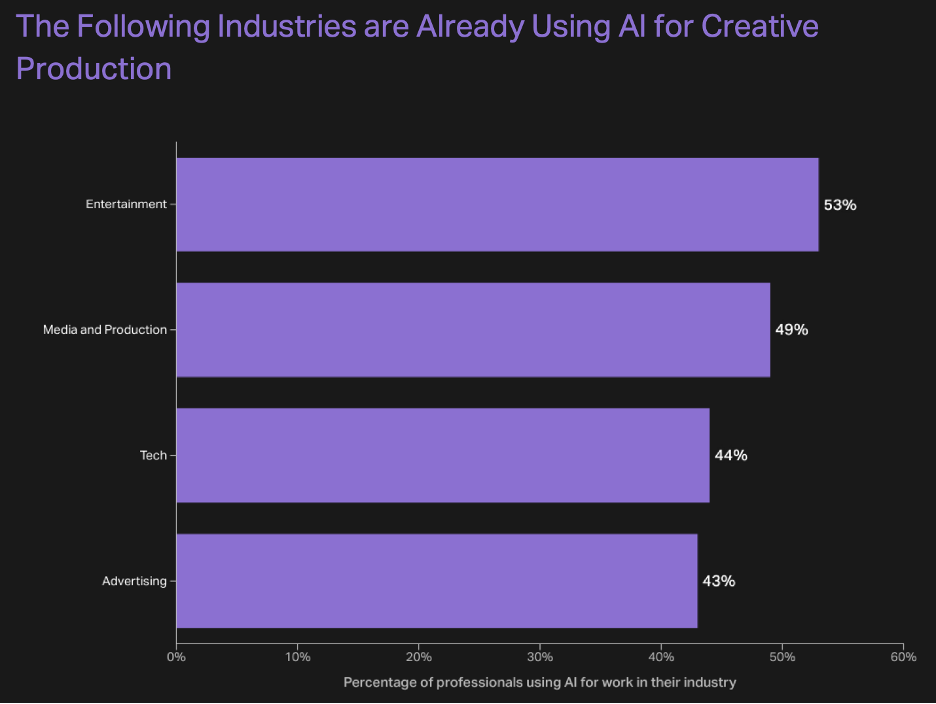
From a social impact perspective, 64% of survey respondents believe that AI can positively impact global problems. The top issues on their minds were education, public health, the environment, and safety.
A few of the tools cited as using AI to improve or solve global problems include:
- Fingerspelling – learn American Sign Language with machine learning
- AI – cutting-edge AI for smarter cities
- Knewton – adaptive learning platform that provides personalized course materials for students
- World Hive Network – gather data analyzed by AI to identify patterns for early bee survival interventions
- NEKO Health – instant results monitoring your health with full body scans
- Global Forest Watch – provides data, tools, and tech to safeguard forests
- Refiberd – utilize AI and robotics for precise textile sorting, ensuring efficient recycling
- Earth Data NASA + IBM – discover insights in NASA earth science data
The Webby researchers conclude that “AI is moving fast, but it isn’t out of reach.” AI has stoked optimism. In addition, partnering with AI can:
- Discover new modes of productivity
- Amplify human creativity
- Create personalized experiences to build customer relationships
- Solve global issues and create an impact.
Pluralsight’s AI skills report 2023 was issued. The five key takeaways from this report are:
- 87% of organizations plan to increase AI spending in the next 12 months.
- 95% of executives and 94% of IT professionals believe AI initiatives will fail without staff who can effectively use AI tools.
- 81% of IT professionals feel confident that they can integrate AI into their roles right now but only 12% have significant experience working with AI.
- 74% of IT professionals worry that AI tools will make many of their day-to-day skills obsolete.
- Only 40% of organizations have formal structured training and instruction for AI.
The last item reported by Pluralsight is “as organizations accelerate AI adoption, the majority don’t understand what, if any, AI skills their employees possess or have an upskilling strategy to develop them.
AI Webinars
AACU announced a free webinar on January 10th titled AI and Higher Education: Implications for Learning, Curricula, and Instruction. Panelists include: Bryan Alexander – Georgetown University; Gilda Barabino – Olin College of Engineering; William McKinney – CAEL; Lynn Pasquerella – AAC&U, and Michael Roth – Wesleyan University.
Future of Work
LinkedIn CEO Ryan Roslansky authored an article for the Harvard Business Review titled Talent Management in the Age of AI. The premise of his article is that the old playbooks for sourcing talented employees will not work in the age of AI. He writes that focusing on three shifts will enable businesses to succeed.
The first shift is redefining jobs as a collection of skills and tasks instead of titles. When jobs are viewed in this manner, CEOs will be able to see which jobs are more prone to be automated. Employees with tasks about to be automated can be upskilled.
The second shift is that leaders need to prioritize workforce learning at the center of talent management. It will be impossible for a one-off moment like a degree to last an entire career. Upskilling and tours of duty can guide employees into new functions.
The third shift will be for employees to embrace AI to enable teams to focus on human-to-human collaboration. LinkedIn estimates that 80% of its members can use AI to automate at least a quarter of the mundane and repetitive tasks that they do every day. Using AI, recruiters can spend more time with candidates and salespeople can deepen customer relationships.
Final Thoughts
It took me a while to run through the 39 AI-related emails I received over the last day and a half. I would normally not read all of these. I would definitely not access all of the reports, read them, and summarize them.
I can understand why people are a little overwhelmed with AI news. At the same time, it is an opportunity (in my opinion) for individuals wanting to enhance their career and/or their company or school by beginning to utilize some of these tools.
As for me, I have two takeaways from this exercise. First, I’m making sure I upgrade to Microsoft Office 365 with co-pilot asap. I’ll try to utilize all of its features. Second, I may have to start using Artifact. If I can use this AI tool to sort and summarize my AI-related newsfeed, I won’t have to do this again.

